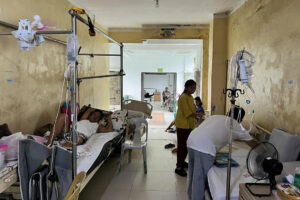In October, three major hospitals in Samar and Leyte asked patients to stop coming to their emergency rooms. North Samar’s Provincial Hospital was “in chaos” (Philippine News Agency, Oct. 27); the Samar Provincial Hospital was “overwhelmed” (Inquirer, Oct. 9), while on Oct. 5, the Regional Medical Center in Tacloban sent an advisory that its emergency room was 193% “over capacity.”
Epidemic? COVID’s return? None of that; there was no disease outbreak, just “an increase in common cases such as diarrhea, measles, respiratory infections, influenza-like illnesses and injuries from vehicular accidents” according to Samar health officials.
Hospital officials were literally begging lower-level hospitals and local health clinics (Rural Health Units in particular) to stop sending patients, asking them to take care of uncomplicated cases.
The East Visayas Medical Center, which President Ferdinand Marcos, Jr. visited in mid-August to look at its Zero Balance Billing program, announced by Oct. 5 that with its 1,100 beds 125% occupied, it could only accept “Level III cases” or those requiring life-saving interventions. It warned that “referred patients may need to remain in the referring ambulances” while attending to patients who came earlier.
At breaking point, the hospitals in Samar and Leyte were asking primary care clinics to provide healthcare for their constituents. That is the way it should be.
Howling in the wind, the primary healthcare system has been on a downward spiral for over a decade, years before the COVID-19 epidemic, which further accelerated the decline of primary care.
FUNDING THE WRONG END OF HEALTHCAREThe Philippine Health Insurance Corp. (PhilHealth) spent P200 billion for hospital-based care and dialysis as of end-September and Department of Health (DoH) reports using 52% (P20.5 billion) of its Medical Assistance to Indigent and Financially Incapacitated Patients Program (MAIFIP) Fund to top up PhilHealth spending, for a total of P220 billion for hospital-based care. Primary care facilities (where 57% of the population goes for healthcare) on the other hand got only P1.3 million in the first six months of 2025. Konsulta/YAKAP clinics, where patients were registered on the average, were paid P510 per registration through First Patient Encounters (FPEs), without having to provide any healthcare.
The Philippines has been neglecting primary care, investing only 4% of current health expenditure for primary care, equivalent to $6 per Filipino, while ASEAN counterpart spending averages $20.
The Universal Health Care (UHC) law specifically directed PhilHealth to craft a comprehensive outpatient benefit package within two years of its enactment. It duly transformed its Tsekap package into the Konsulta package by 2020, allocating P500 per year for every member and beneficiary.
Instead of directly funding primary care in 2,797 government facilities immediately, PhilHealth prioritized registration of its members into Konsulta (now YAKAP) without providing an ounce of care, a tablet of medicine, or a blood test. When the Philippine Statistics Authority conducted a Community Based Monitoring System survey in two provinces in the Samar/Leyte region in 2022, patients were found to be routinely bypassing health centers, going directly to hospitals. These patients reported that less than 10% of their health costs were covered by PhilHealth, making their out-of-pocket costs 90% versus a national average of 44%.
PhilHealth has been seemingly reluctant to roll out the Konsulta package (it would cost P190 billion per year at the expanded rate of P1,700 per Filipino). PhilHealth management instead accumulated large amounts in its reserve as it chose to ration out primary care.
With its reserves spent on expanded and increased hospital benefits, PhilHealth now finds itself strapped for resources after two years of underfunding and non-funding and giving up P60 billion to the National Government. The constitutionality of the transfer is being challenged by a petition at the Supreme Court.
Primary care health services which are starved of funding are deteriorating while the system prioritizes higher levels of care. The absence of preventive public healthcare is now being felt by hospitals where up to 33% of their patients could have been managed at primary care clinics1.
CAN’T DELIVER FULL BENEFITSThe data would suggest that it would be a futile exercise for patients to even seek care from a Konsulta/YAKAP provider when they get sick. In May 2024 a DoH-funded survey2 of 70 UHC implementation sites showed that only 6.1% of 2,797 accredited Konsulta facilities nationwide could deliver the full Konsulta package.
When the Konsulta package was launched in 2020 by PhilHealth, it accredited all 2,797 government facilities, without checking if they could deliver the entire package. After four years of waiting for the local government units (LGUs) to implement the package with DoH assistance and achieving only single digit in terms of percentage of facilities able to deliver the full Konsulta package, the primary care system has failed. Patients are choosing to bypass health clinics/primary care that can only register them and instead go directly to the hospitals for healthcare.
LGUs have not been funding local health systems at the levels required by the UHC law, covering only 9.3% of health expenditure by 2023, barely increasing from 8.9% in 2020. On the other hand, DoH and PhilHealth management were more worried about their agencies’ performance and passively waited for LGUs to catch up.
Moreover, the local health system has been marginalized by attention-seeking national programs which compete with local health service delivery without improving people’s health, such as LAB for all caravans, BUCAS centers, and Purok Kalusugan programs.
HIGH-END HEALTHCARE VS PRIMARY CAREA poorly advised President delivered a coup de grace of sorts to the health system when he miscommunicated Zero Balance Billing for all government hospitals in his State of the Nation Address last July. It was no coincidence that Samar Provincial Hospital started seeing increasing numbers of patients in August, with over 200 patients occupying its 100-bed capacity facility.
The unraveling of the health system in Leyte/Samar that followed is an example that exposes the extreme vulnerability of the current state of UHC in the Philippines.
Yet the best solution that DoH and PhilHealth can come up with is to ask for more resources to shore up the Zero or No Balance Billing program for national hospitals and probably extend assistance to local hospitals.
Without the benefit of assessing the entire health system, the administration can only offer unsustainable measures like increasing subsidies that cost the most — secondary and tertiary hospitals and specialty medical centers.
But the political leadership does not allocate sufficient resources for primary care, which can reduce higher end healthcare costs. Every new hospital benefit announced by PhilHealth reduces its capacity to fund primary care.
RESCUING THE PHL HEALTH SYSTEMOne can only suggest that the first steps to change course can begin with the current health budget deliberations.
The proposed 2026 PhilHealth General Appropriations budget will only cover P53 billion in premiums of the indirect members. The premiums of all indirect contributors — which are used to fund benefits of all PhilHealth members — are guaranteed by the UHC law. But the proposed 2026 PhilHealth budget will only cover less than a third of reimbursements made by indirect members in 2025, which is expected to exceed P160 billion.
Further, the expansion of the MAIFIP program, an example of abetting multiple funding streams, would result in diminishing PhilHealth’s role to give financial healthcare protection to all Filipinos. Different health funding programs are administratively costly, and they inflate health costs, according to the Philippine Institute for Development Studies-Health Economics and Finance Program team.
PhilHealth’s operations will exceed P300 billion in 2025, overshooting its P286-billion budget. PhilHealth’s 2026 budget, conservatively, should be north of P360 billion. The MAIFIP fund should thus be transferred to cover PhilHealth’s funding gap, particularly in covering reimbursements. With reimbursements soaring to 94% from 2024 to 2025, PhilHealth needs all the resources it can get to cover costs.
The shares of the Philippine Amusement and Gaming Corp. (PAGCOR) and the Philippine Charity Sweepstakes Office (PCSO) for UHC could be used for primary care, separate from the reimbursements for hospital care. The Department of Budget and Management (DBM) must release to PhilHealth P42 billion from the 2023 and 2024 General Appropriations Acts, which the DBM impounded. Another P42 billion, the combined amount for 2025 and 2026 due from PAGCOR and PCSO as mandated by the UHC law, must be allocated to PhilHealth. These amounts can be repurposed to cover the 2026 spending for YAKAP/GAMOT.
Congress can also provide a special provision that will limit benefit expansion in hospital care for the next two years at least, to be lifted only when the comprehensive outpatient benefit package at primary level is largely in place.
These are our urgent proposals to save the Philippine healthcare system.
1 “How to reduce Out of Pocket spending in the Philippines,” PIDS Health Economics and Finance Program
2 Final Report Universal Health Care (UHC) Survey, DoH, June 2024
Juan Antonio Perez III, MD specializes in public health administration, primary healthcare, and has worked with nine Health Secretaries and three NEDA Secretaries since 1992. He was undersecretary for Population and Development and executive director of the country’s Commission on Population and Development up to Sept. 8, 2022 when he retired. He occasionally writes for Action for Economic Reforms.


















